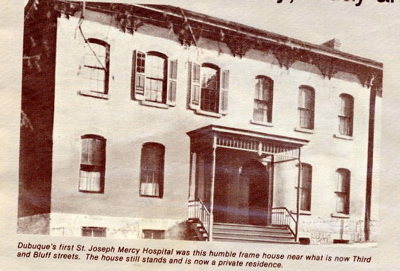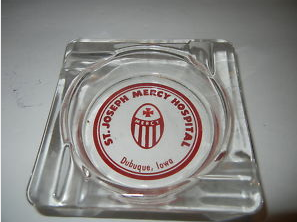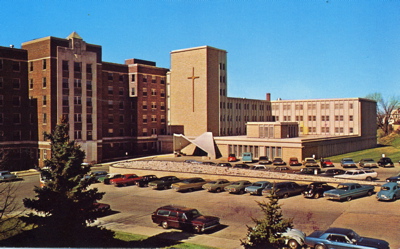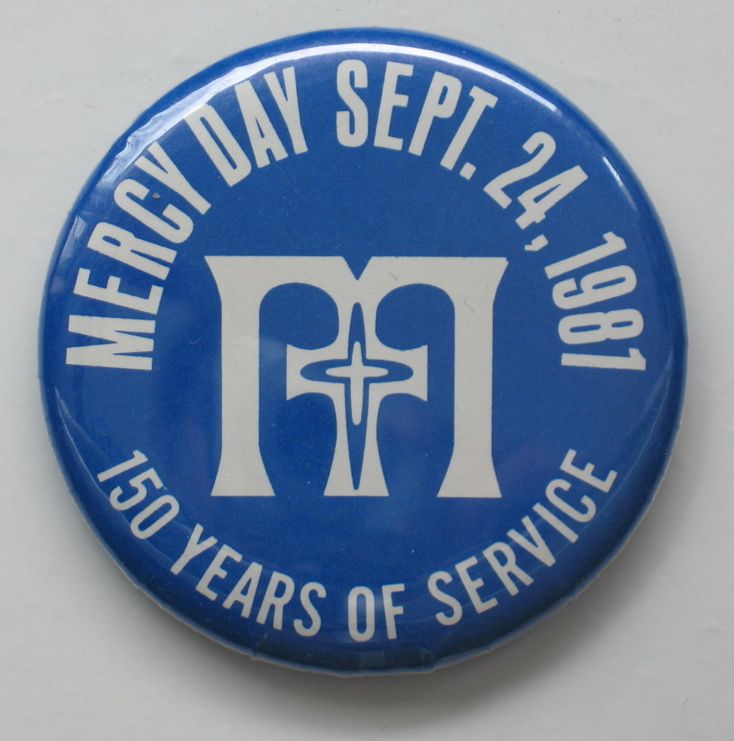Encyclopedia Dubuque
"Encyclopedia Dubuque is the online authority for all things Dubuque, written by the people who know the city best.”
Marshall Cohen—researcher and producer, CNN
Affiliated with the Local History Network of the State Historical Society of Iowa, and the Iowa Museum Association.
MERCY MEDICAL CENTER
MERCY MEDICAL CENTER. The second hospital established in the State of Iowa by the SISTERS OF MERCY and quickly the largest hospital within Dubuque and Jackson counties in Iowa; Jo Daviess County, Illinois; and Grant County, Wisconsin. In 1879, at the request of Bishop John HENNESSY, the Sisters of Mercy established the first St. Joseph's Mercy Hospital in a house at the corner of Third Street and Bluff. The first patient was an 86-year-old Irish woman. Within one year the hospital had outgrown its home and moved to larger quarters on the site where Mercy Health Center stands today. The medical staff in the early days of the hospital included ten physicians and the sisters who, in addition to their attention to spiritual needs of the patients, cooked, washed, ironed, and cleaned. A $25,000 surgical annex was opened in 1892. In 1900 Mercy's nurses' training school began instruction including the proper methods of bed making, dusting, dressing wounds, and the application of leeches. This school was closed in 1974.
Continued expansion included the construction of a $200,000 addition in 1905 that nearly doubled the hospital's size. This addition also housed the area's first permanent operating room and boasted an X-ray machine. This addition was thought to make Mercy the largest hospital in Iowa.
In 1947 the $2,500,000 expansion increased Mercy's capacity to over four hundred beds. On February 8, 1970, the new medical center was dedicated which combined the St. Joseph Mercy Hospital, SAINT ANTHONY'S HOME FOR THE AGED, and SAINT JOSEPH'S SANITARIUM for the mentally ill. The resulting $8,500,000 facility received funds from the Hill-Burton Act for hospital construction, mental health monies, and a $1,100,000 community fund drive headed by Postmaster Charles J. MURPHY who coined the phrase,"The Umbrella of Mercy." This was the largest community fund drive of Dubuque's history to that time.
In March 1970, Mercy began the first INHALATION THERAPY TECHNICIANS SCHOOL in Iowa. At the time Mercy employed three of the estimated ten inhalation therapists in the state.
The patient areas of the building constructed in 1947 were remodeled in 1972-1973. With the expansion of services, Mercy became Dubuque's third largest employer. The operating budget rose from $3,500,000 in the 1960s to over $27 million by the start of the 1980s.
In a 1971 study, Hamilton and Associates recommended locating doctors' offices near the hospital. This was followed in 1975 by the move of the MEDICAL ASSOCIATES office building to its present location. On July 1, 1976, Mercy Health Center became a division of the Sisters of Mercy Health Corporation, the nation's largest Catholic health system. Mercy Health Center merged with the Dyersville Community Hospital on January 1, 1978, leading to the creation of Mercy Health Center, St. Mary's Unit, Dyersville and St. Joseph's Unit, Dubuque.
In 1982 Mercy merged with the Franciscan-operated XAVIER HOSPITAL. Today designated a regional health center, Mercy is home of the Northeast Iowa Regional Perinatal Unit, Substance Abuse Treatment Center, and the Eastern Iowa comprehensive mental health center in addition to being the Trauma Center for Northwestern Illinois and the Iowa-designated Poison Information Center.
One of the most meaningful benchmarks for hospitals has become the Magnet designation. In 1981, during a serious shortage of nurses, the American Academy of Nursing commissioned a study to identify hospitals with the best nursing practices in the country. The term “Magnet” was adopted to describe these select hospitals, because they acted as magnets in attracting and retaining outstanding nurses. Since that time, the American Nurses Credentialing Center has formally recognized only 289 hospitals across the country for meeting the rigorous standards required in achieving this prestigious award.
Mercy Medical Center received Magnet status in November 2004 and became the 134th hospital in the country and the second of only two hospitals in Iowa to receive the designation to date.
In March 2012, Mercy Medical Center announced that the construction of new intensive-care and cardiovascular units had a target completion date of August. The project included 22,000 square feet of renovated space and about 8,000 square feet of new construction. Features included small areas for nurses outside the patients' intensive-care rooms and larger rooms to facilitate equipment for tests. Instead of taking patients out of their rooms, testing equipment would be brought to the patient. (Photo Courtesy: http://www.dubuquepostcards.com)







